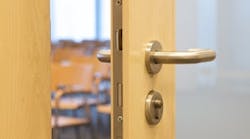Green paints contain low or no VOCs. Green desks, chairs, and carpets contain recycled content and are at least partially recyclable. The greener versions of building products and furnishings have characteristics that distinguish them from their traditional counterparts.
What characteristics make a green door more sustainable than its traditional counterpart?
“There is very little difference between a traditional door and a ‘green’ door in terms of outside appearance and function as a door. A door is a door,” says William Worthen, director, resource architect for sustainability at the American Institute of Architects (AIA).
“A better question would be, 'Why isn’t every door that is manufactured today made with glues and adhesives that are not harmful to humans and made from wood, substrates, and veneers that are legally logged and/or sustainably forested?'" he continues. "We know how to do it, and the industry can pretty easily change operations to make every door a green door, and they all look and feel the same. Green doors are just made from less harmful products and will not off-gas volatile organic compounds over their life and use."
What Makes It Green?
Even though a door is a door, there are some slight differences between green and traditional doors. Aside from making the door LEED or Green Globes friendly, these differences will almost certainly go unnoticed.
“The main difference for a wood door is that the wood used in a green door is Forest Stewardship Council (FSC), Sustainable Forestry Initiative (SFI), or otherwise identified by an organization as being of certified wood,” explains Jeffrey Lowinski, vice president of technical services for the Window and Door Manufacturers Association (WDMA).
“The rules vary by organization, but essentially it means that the wood used is harvested in a sustainable manner, does not come from endangered lands or habitats, and is traceable to the source where it was harvested,” he explains.
As long as the door is made of certified wood, the question of greenness lies with green certification programs, like LEED, Green Globes, and other environmental rating programs. These programs have factors for determining a product’s greenness, including recycled content, the use of regional, rapidly renewable, and low-emitting materials, and other concerns, Lowinski explains: “Almost all wood doors contain these attributes – it is just to what extent that may determine whether the door qualifies as an acceptable product.”
Other green factors include low- or no-VOC glues and adhesives and door cores made from environmentally friendly composite wood products. These factors make a green door different than a traditional “business as usual” door, says Worthen. The door’s fire rating, aesthetics, and detail shouldn’t suffer just because a door is green.
“The way that an environmental door is manufactured is quantified by its lifecycle assessment, which includes all of the factors that go into determining its sustainability,” Lowinski explains. “This includes its materials, finishing, sourcing, longevity, and disposal. In addition, the plant itself may be environmentally friendly by the way it processes waste or uses energy.”
How You Get Green
The work that goes into selecting a green door doesn’t differ much from selecting a traditional door – you just have to communicate to your door specifier that you want your door to be green. “Choosing an environmental door is one more factor that goes into the specification process, as does the door appearance, function, and handing,” Lowinski explains.
If you opt to select the door yourself instead of using a specifier, there’s a little more research involved, but it can be done. “You need to understand how doors are made, know what to ask for, and how to specify a door based on its construction, wood product sources for the core, solid stock, and veneers,” Worthen says. “Make sure the wood sources are legally logged and come from FSC-certified forests. Check and require Material Safety Data Sheets (MSDS) for all the glues, adhesives, and sealants that go into making the door.”
“If you don’t know what to ask for, find a licensed design professional who understands construction specifications. You should not have to pay more for an environmentally friendly door,” he concludes. “Ask for them and make sure you are getting what you asked for.”
Kylie Wroblaski ([email protected]) is associate editor of BUILDINGS.


